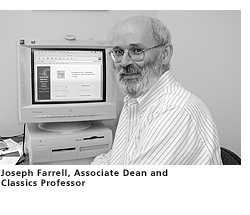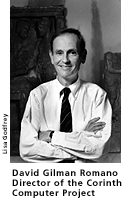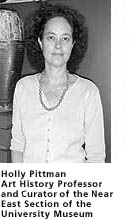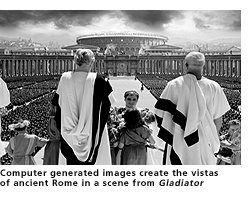
OLD WINE IN NEW SKINS
TECHNOLOGY AND THE STUDY OF ANTIQUITY
"It's a funny irony," observes classics chair Sheila Murnaghan, "that we classicists have been at the forefront in the use of technology in studying the humanities. We might seem like the last to pick up on new ideas, but in fact classical scholars have been right out there, I think partly because there's always been this technical component to the study of the classical past."
Murnaghan's point is that the world of antiquity is in some sense a laborious reconstruction by scholars. Ancient texts, for instance, are usually assembled from a variety of later manuscripts, and historical events frequently must be recovered from a combination of sources, say, mythic narrative and the inscriptions from eroded monuments. Classicists quickly discovered that advances in information technology provided them with ideal tools to do the painstaking work of recovery and reconstruction that they have always done—and to do it better.

Doing Things with Texts
Joe Farrell, associate dean for graduate studies in SAS and a classics professor, remarks that his love of Vergil's poetry is not "intrinsically related" to his interest in computers. "It could have been attached to almost any material at all," he says of the technology he uses to assemble and publish classical scholarship on the World Wide Web. "For years people in classics had been doing things with texts," including the digital compilation of classical works that could be searched for key words and phrases. "What I understood [early on] was that, with the World Wide Web, you could get a text that looked just like a printed book, but every word could be linked to all kinds of information." Links to the apparatus of scholarship might include variant texts, commentary on poetic style and meter, notes on recurring themes and motifs, a dictionary, an encyclopedia of mythology, an atlas, a history book, or a set of pertinent images. It's a more efficient way of doing what classical scholars have done—combining texts with commentary—and it's the basic idea behind Farrell's Vergil Project (http://vergil.classics.upenn.edu/).
The project is a database of interconnected resources for teaching and research on the poet the ancient Romans considered their greatest. The website is designed to be useful to novice and professional scholars, casual browsers, and elementary or high school pupils. Movement back and forth between the poet's text and the commentary is accomplished by a click of the mouse, making the database not just a bigger and more comprehensive resource than any printed book but one that's far easier to use.
The Vergil Project also provides a forum for interested students and scholars to collaborate. There are spaces for individuals or classes or groups of scholars to create their own versions of the poems along with customized textual commentary, and a portion of the site is dedicated to the compilation of a "communal text" and commentary."I wanted to make the Vergil Project a repository of information that lots and lots of people could use but also that lots and lots of people could contribute to," he explains, "something that could receive an interesting insight from a rank amateur as well as a seasoned scholar."
Contributors need to compose their commentary so that it is accessible to all of the site's users, neither too dumb for specialists nor obtusely pedantic. Farrell argues that writing for a broad audience demands just as much knowledge of the subject matter as writing a traditional scholarly monograph directed at one's peers. The communal text also benefits from the unexpected perceptions of "ordinary" readers of Vergil who can become involved in scholarship that was once the preserve of senior scholars.
One of the questions that has dominated Vergilian studies has been whether the poet was a supporter of Caesar Augustus or a critic as Rome turned from republican rule to a cult of the emperor. "My own sense of what's important in a poem like the Aeneid has changed," notes Farrell. "Just coming up with a way for people to express their interests in the poem and share their interests with others is more important than the position that I might take up in a question like that. What I learned collaborating on the Vergil Project is that there are lots of people who teach the Aeneid year in and year out. For them, it's more a matter of introducing students to the world of the poem than of making decisions about Vergil's political beliefs. That's the abiding strength of the poem. It's good to be reminded of that."

Building Rome in a Day
David Gilman Romano, Gr'81, director of the Corinth Computer Project, says his undertaking would have been "absolutely impossible" without modern technology. "We are dealing with very precise measurements, precise locations, and precise orientations of buildings, of roads, of different elements of the ancient Roman city. It has meant that we could be very secure in the conclusions that the project is producing."
Romano is a senior research scientist at Penn's Museum of Archeology and Anthropology. Tall and lanky with narrow shoulders, he often looks as though he doesn't quite know what to do with his long limbs. Over ten summers, beginning in 1988, he led teams of scientists and students on expeditions to the excavation site of the city first colonized by the Romans under Julius Caesar in 44 BC. The aim of the project was to produce a highly accurate map of Corinth using the precision tools the new information technology was making available.
The original Greek city-state was destroyed by the Romans in 146 BC, the same year Carthage was leveled. The Corinthians had led Greek opposition to Roman rule. To underscore their point, the empire builders slaughtered the city's male population and sold the women and children into slavery. A century later the Romans built a colony on top of the Greek ruins, incorporating some of the remaining structures into a new city plan. This is the urban configuration that Romano wanted to document, along with later accretions that grew out of it.
The groups used sophisticated computer- and laser-assisted devices called "Total Station" to survey all the above ground structures and monuments as well as roadways and the surrounding landscape. As a graduate student at the American School of Classical Studies at Athens in the late 70s, Romano worked at the site, and his subsequent research there has been carried out under the continuing auspices of Charles K. Williams II, Gr'78, Hon'97, a Penn trustee and director of the American School's Corinth excavations until 1998.
The fieldwork provides the backbone of data for the Corinth Computer Project, but researchers have also digitized and integrated topographical maps, aerial photographs, and satellite images. By drawing on a range of sources, the project managers were able to uncover detail that supplemented the field data. The aerial photographs, for instance, revealed "crop marks," shadowy lines that mark former roadways or ancient property divisions, that were invisible from ground level. "The traditional approach," notes Romano, "would have been to piece together many, many paper maps and then try to draw conclusions based on what you think you could see. Because of the computer, it's not a guess."
Since the field work was completed, the harvest of data has been entered into and parsed by software that architects, civil engineers, and surveyors use, and some of the results are accessible on the website for the Corinth Computer Project (http:// corinth.sas.upenn.edu/corinth.html). For the last five years, the bulk of the technical work has been carried out under the eye of research associate Nicholas Stapp, GFA'00, who oversees the project's tiny lab in the museum and trains the undergraduate and graduate students working on this phase of the project. More than 70 students have worked on the project over the last 12 years.
Visitors to the website can zoom in and out of interactive city plans, read special text sections about the city's history, or view a 3-D fly-over of the landscape. The project's researchers have digitized sketches and photos that were produced as each structure was unearthed during the century-old excavation of Corinth. The incorporation of these records allows visitors to click on individual buildings and obtain stone-by-stone information on date, material, and function. It's also possible to descend through color-coded layers and view maps of the city's configuration as it changed through successive periods of colonization. Romano and his colleagues have discovered the grid system the Romans used to lay out the city and also found evidence for agricultural land planning associated with a later colony that was settled during the rule of Vespasian in the 70s AD. "They divided up the land a second time for tax revenue," explains Romano. "Vespasian was famous for being very economical and bringing in new revenue after the escapades of Nero and some of his predecessors."
Romano is preparing the final publication of the Corinth Computer Project, which will be aimed at scholars and will consist of a monograph, a map gazetteer, and a CD. "This is not just a city," he observes, "it is a very important ancient city. So this [project] will be the model for future archaeological excavations."

Movies in Stone
Before coming to academia, Holly Pittman, a professor of art history and curator at the university musuem, worked as a curator of the ancient near eastern collection for New York's Metropolitan Museum of Art. She studies what she calls the "material culture," as opposed to the "textual culture," of ancient Mesopotamia. "I'm interested in image making and what its function and meaning was for the ancient societies that produced it." It's not that she doesn't traffic in the currency of words—she is a scholar, after all—but her initial approach to the objects is visual rather than strictly verbal.
Pittman has a high forehead and thick brown hair with glasses planted in the curls on top. When speaking, she often comes down hard on the vowel sounds and draws them out. "I still do all my reconstruction first by hand," she confides, "and then work it out in a digital fashion. That won't be the case for fu-oo-ture generations." When reconstructing a complex series of images, she photocopies them, usually from book illustrations, and then shuffles around the paper trying to come up with an arrangement that makes some narrative sense.
One such "program" of images she has worked on are the relief panels that lined the throne room walls of the Assyrian king Assurnasirpal II (883-859 BC). The eight-feet-high carvings were excavated in the nineteenth century along with the ruins of the great palace. Many are now on exhibit in the British Museum and elsewhere. The series of relief panels told of conquest, of the bringing of tribute, and of the enactment of religious ritual. It was a propaganda narrative, says Pittman, aimed at convincing those who entered into the presence of the king that his reign was inevitable and good.
The only way to see these images now is as individual art works either in museums or on separate book plates. The original environment in which they were intended to be displayed as a single work is long gone and with it the integrated visual experience.
In the early 90s, Pittman and one of her students, Francine Jaskiewicz, C'94, collaborated on a class project to design a three dimensional walk-through of the lost throne room. The architecture program in the Graduate School of Fine Arts provided substantial technical support. Jaskiewicz first taught herself to use an early version of AutoCAD, commercial software for computer-assisted design. She then made about 4,000 scans to digitally record 20 drawings of the relief panels. To link all the digitized images together to produce the seamless illusion of moving back and forth through the space, the computer had to process the data for a week—until it finally "died." The result is a six-minute virtual tour.

The ancient artisans who built the palaces of Assyrian kings had developed a way of telling stories in pictures. Pittman likes to compare the technique to cinema. "It's almost like they figured out how to do movies in a still format," she says. "Rather than sitting in a theater [to watch a movie], the viewer would walk along to make the images 'move.'" Jaskiewicz's virtual tour enables students to overcome the handicap of seeing the art in the usual fragmentary way. When Pittman's students saw all of the images as a coherent ensemble, as part of the architectural space the reliefs were intended for, they were astounded. "Oh," they would say to her, "so this is what you have been talking about all this time."

Pittman believes the kind of virtual-reality technology now used for movies and entertainment will soon be used extensively in education. Sophisticated virtual-reality games already available at some arcades could reconstruct the experience of being surrounded by the art in the throne rooms of Assyrian kings or in other long vanished ancient structures. "For sure, that's where it's headed," she says. "The movie Gladiator is a wonderful example. They digitally reconstructed Rome, and it was very impressive. In terms of the visual presentation, it was certainly the most effective reconstruction of an ancient setting that I've seen so far, and that's just the beginning. Putting on all of the virtual-reality apparatus, you will be able to actually go in and actually move around in those spaces."
In the near term, she plans to work with an enterprise called Learning Sites, which uses computer and virtual technology to create products for teaching, research, and museum exhibits. Recently, she has been studying the White Obelisk, a rectangular pillar with carved images and text on four sides. The monument was unearthed in the ruins of ancient Nineveh, one of the most important cities of the Assyrian empire. Pittman believes the images are reproductions of glazed panels or paintings that adorned the walls of a lost palace. She hopes to reconstruct the "hypothetical architectural setting" in which these images would have been deployed using the more sophisticated resources of Learning Sites. "I'm very excited about the technology," she says. "I just look forward to the time when it's as easy to use as photocopiers, or cutting and pasting a cardboard model."